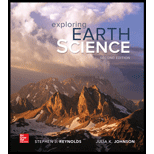
The characteristics of glaciers along with the three main types.
Answer to Problem 1BYL
Glaciers develop in the region where the accumulation rates of snow and ice are greater than their melting rate. The regions with greater snowfall and the regions experiencing extremely cold climate also favor the formation of glaciers. Glaciers may be almost straight or slightly curved in the case of simple flows, whereas they may be twisted and folded in case of complex flows. They erode their bedrocks through plucking and abrasion. The erosion would bring about crevasses in the glaciers.
There are principally three types of glaciers, which include ice sheets, valley glaciers, and piedmont glaciers. Ice sheets form the largest ice accumulations that store up a large quantity of water within them. The glaciers that are generally confined to valleys are known as valley or alpine glaciers. When the valley glaciers or ice sheets move out of the mountains to a low-lying region, they form a piedmont glacier.
Explanation of Solution
A glacier represents a thick and huge ice mass that formed about hundreds or thousands of years in the geological past. Snow accumulates and gets thickened, compacted, and re-crystallized to form a glacier. Glaciers are formed at the regions where the accumulation of snow and ice is at a faster rate compared to their melting. Their development is possible only if the region obtains sufficient snowfall that allows the amassing of snow and ice. Generally, glaciers are found in higher elevations or at higher latitudes.
When the snow undergoes burial, it gets compressed into ice and turns blue in the process. Hence, the icy portions of glaciers appear noticeably blue. Most of the glaciers also possess lines, such as grooves, ridges, and sediment-rich streaks, that developed as a result of flow within the glacier. In case if the flow is simple, these lines may be fairly straight or slightly curved; however, if the flow is complex, then such lines may be twisted and folded.
Ice is able to cover extensive regions, whereas glaciers would be confined within valleys as they move from higher elevations to lower ones. When the nearby ice-filled valleys unite, the glaciers also merge and generate a broader and usually thicker mass of flowing ice.
The formation of glaciers might be also influenced by the slope of the region. Slopes that are gentle permit the accumulation of ice and snow to reach ample thickness, whereas steeper slopes like that of a mountain would cause the sliding of ice and snow downslope, rather than piling up.
When a glacier advances forward, its top surface breaks because of the internal stresses. This produces fractures, each of which is termed as a crevasse. Crevasses are particularly well developed and abundant where a glacier moves around a curve, similar to moving around a valley’s bend, or where the land underneath the glacier alters the slope, either from a steeper one to a gentler one or vice versa. The glacier plucks and abrades sediments from its bedrock as it advances forward. The eroded materials would be laid down by the glaciers when they melt.
Glaciers can be valley or alpine glaciers, ice sheets, or, piedmont glaciers. The valley or alpine glaciers refer to the comparatively small glaciers that occupy the valleys previously occupied by the streams. Contrasting with the rivers that flowed swiftly along those valleys, glacial advancing is a very slow process, usually at a rate of few centimetres per day. Valley glaciers tend to be slightly narrow; however, they can move down valleys for about tens of kilometres.
The greatest accumulations of ice occur in continental ice sheets. The large sheets of ice that spread across vast areas of land, which are more in number than the valley glaciers, are the ice sheets. Low solar incoming rays throughout the year favour the existence of these glaciers.
The ice sheets lock up large quantities of water during their formation or when they grow in thickness, which results in a substantial drop in the sea level globally. Hence, when they melt, a tremendous amount of water is released, which causes a considerable increase in the global sea level. Ice sheets, at present, are located in Northern Hemisphere’s Greenland and Southern Hemisphere’s Antarctica.
The glaciers called piedmont glaciers form where one or two valley glaciers emerge from the confining walls of mountain valleys at the base of the steep mountains and their advancing ice spreads out into expansive sheets in low lands.
Want to see more full solutions like this?
Chapter 11 Solutions
Exploring Earth Science
 Applications and Investigations in Earth Science ...Earth ScienceISBN:9780134746241Author:Edward J. Tarbuck, Frederick K. Lutgens, Dennis G. TasaPublisher:PEARSON
Applications and Investigations in Earth Science ...Earth ScienceISBN:9780134746241Author:Edward J. Tarbuck, Frederick K. Lutgens, Dennis G. TasaPublisher:PEARSON Exercises for Weather & Climate (9th Edition)Earth ScienceISBN:9780134041360Author:Greg CarbonePublisher:PEARSON
Exercises for Weather & Climate (9th Edition)Earth ScienceISBN:9780134041360Author:Greg CarbonePublisher:PEARSON Environmental ScienceEarth ScienceISBN:9781260153125Author:William P Cunningham Prof., Mary Ann Cunningham ProfessorPublisher:McGraw-Hill Education
Environmental ScienceEarth ScienceISBN:9781260153125Author:William P Cunningham Prof., Mary Ann Cunningham ProfessorPublisher:McGraw-Hill Education Earth Science (15th Edition)Earth ScienceISBN:9780134543536Author:Edward J. Tarbuck, Frederick K. Lutgens, Dennis G. TasaPublisher:PEARSON
Earth Science (15th Edition)Earth ScienceISBN:9780134543536Author:Edward J. Tarbuck, Frederick K. Lutgens, Dennis G. TasaPublisher:PEARSON Environmental Science (MindTap Course List)Earth ScienceISBN:9781337569613Author:G. Tyler Miller, Scott SpoolmanPublisher:Cengage Learning
Environmental Science (MindTap Course List)Earth ScienceISBN:9781337569613Author:G. Tyler Miller, Scott SpoolmanPublisher:Cengage Learning Physical GeologyEarth ScienceISBN:9781259916823Author:Plummer, Charles C., CARLSON, Diane H., Hammersley, LisaPublisher:Mcgraw-hill Education,
Physical GeologyEarth ScienceISBN:9781259916823Author:Plummer, Charles C., CARLSON, Diane H., Hammersley, LisaPublisher:Mcgraw-hill Education,





